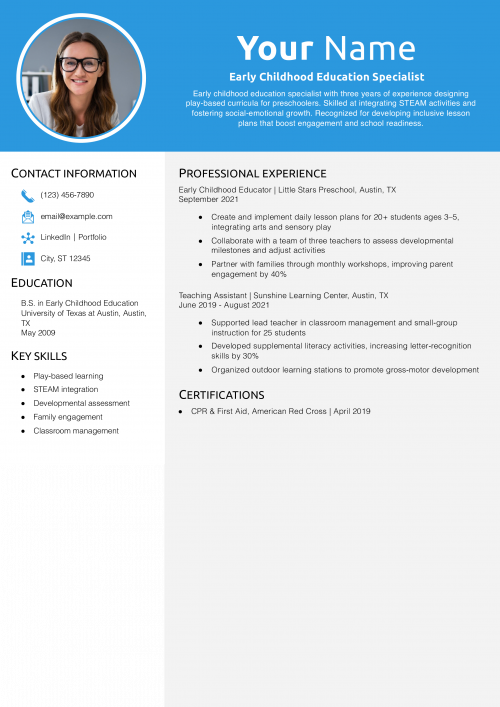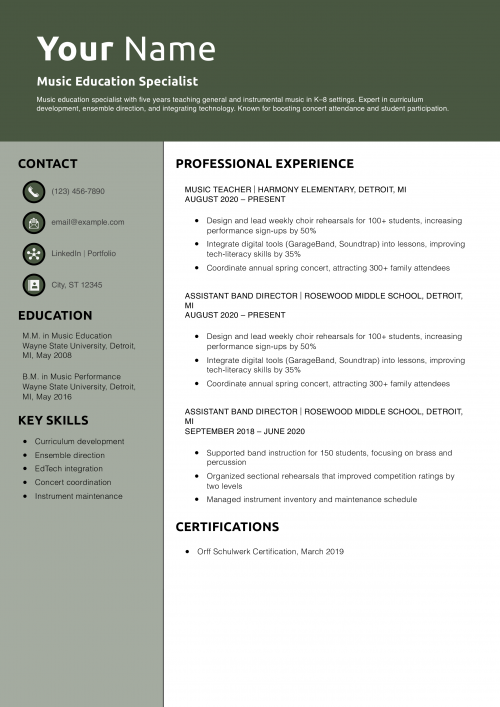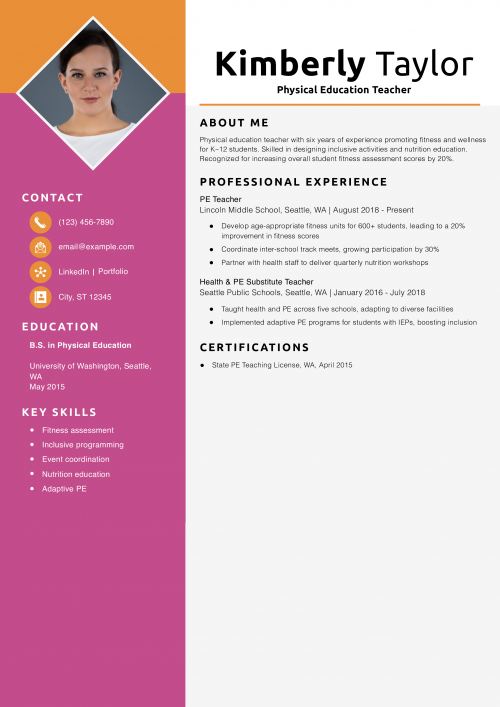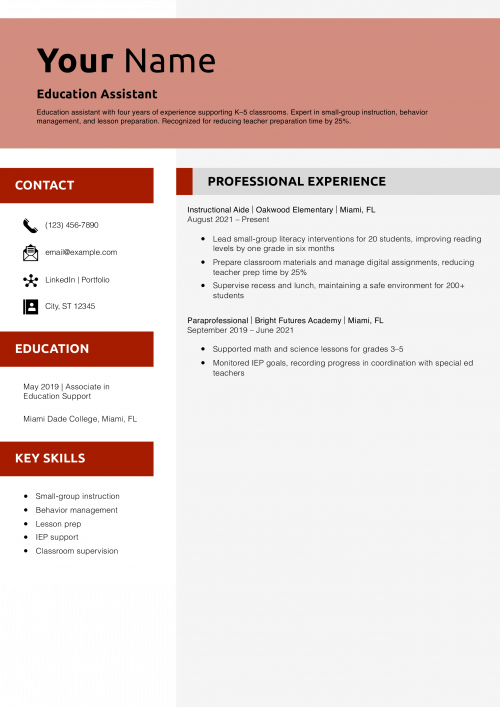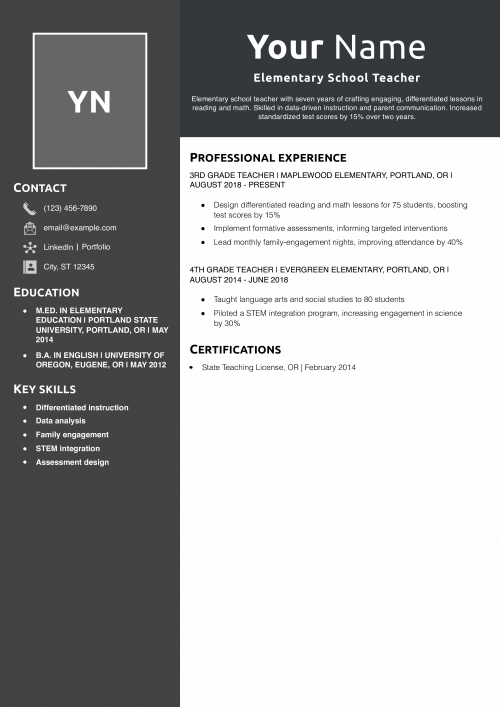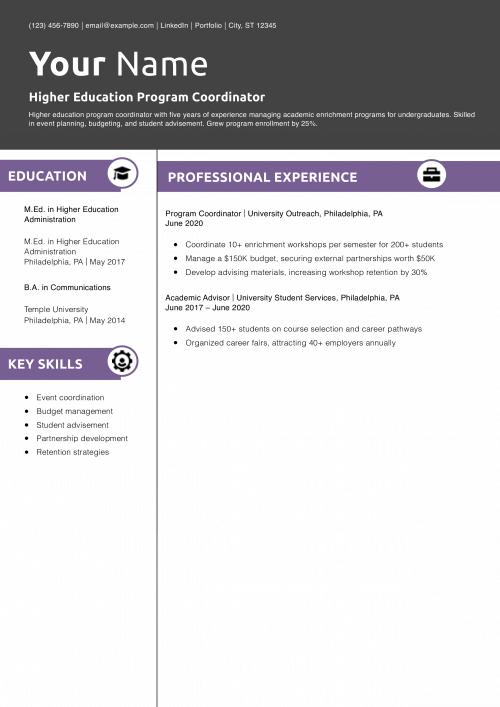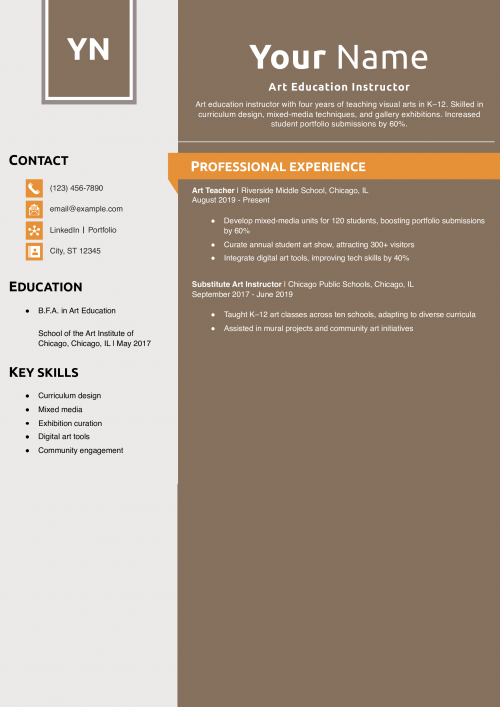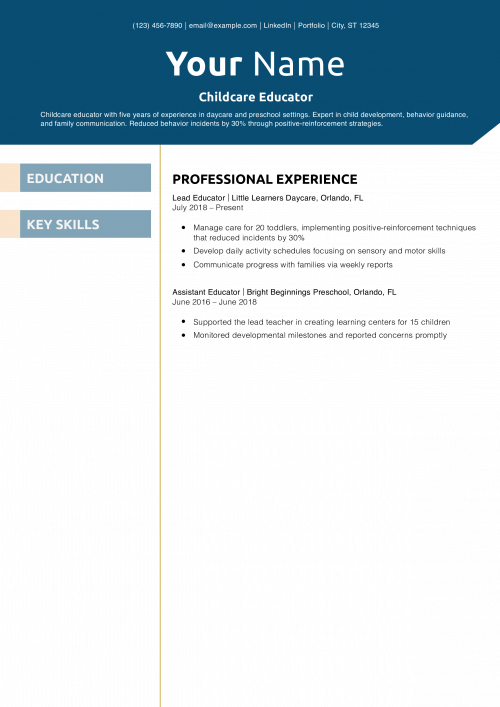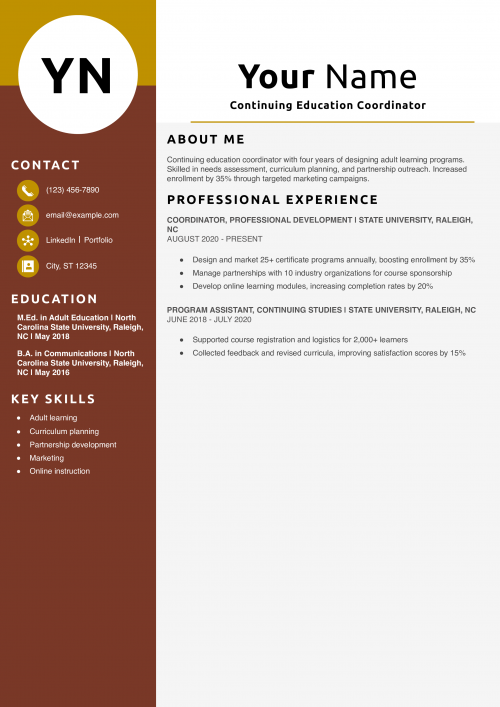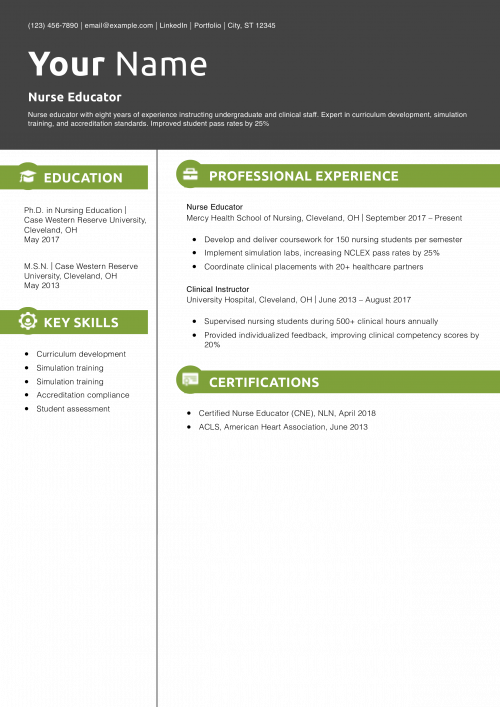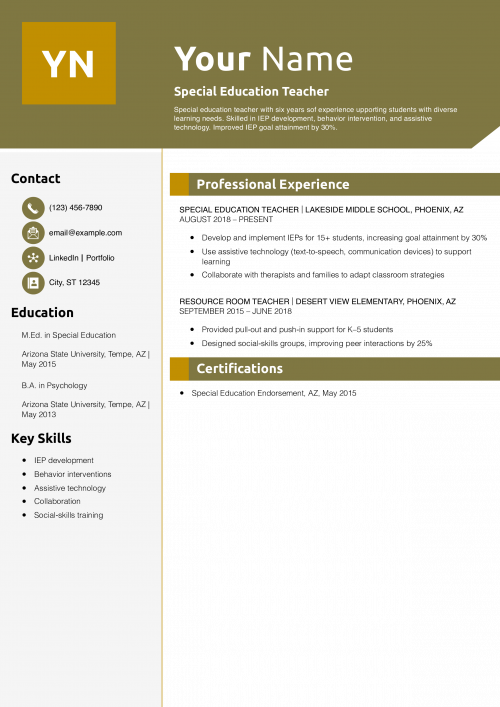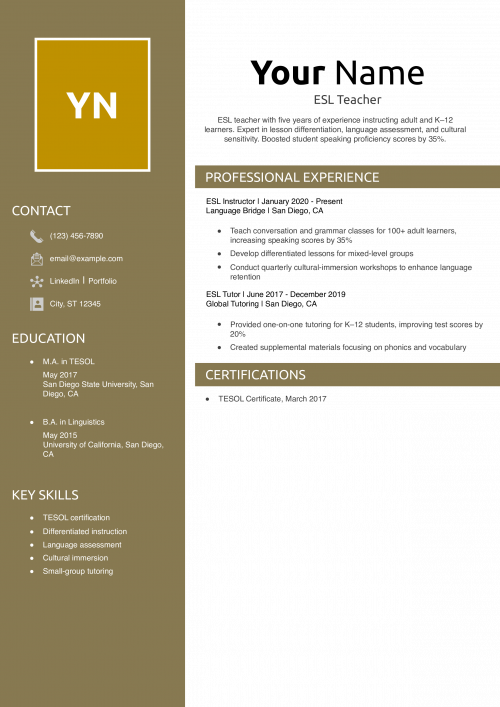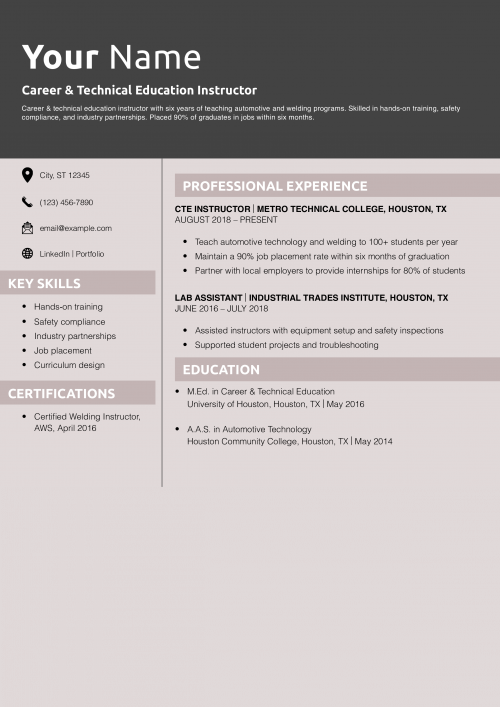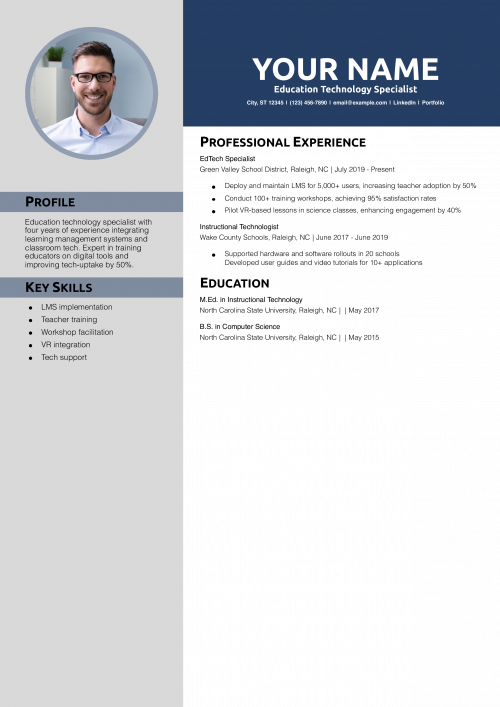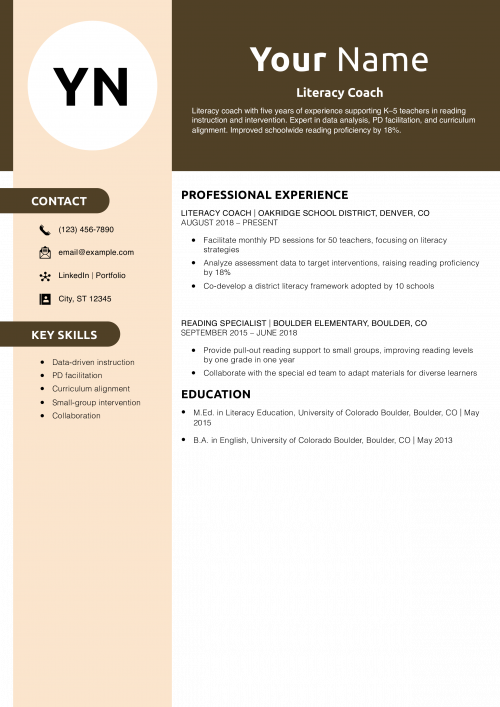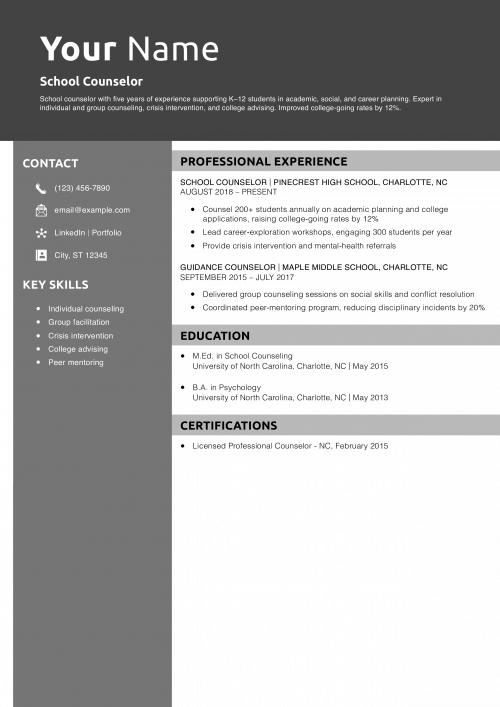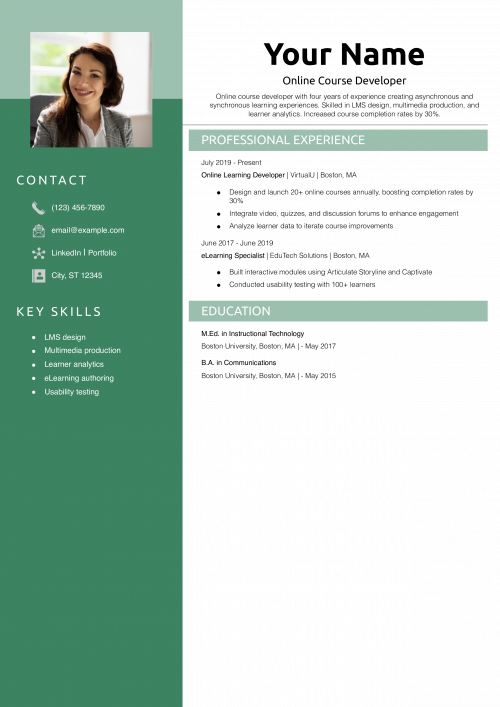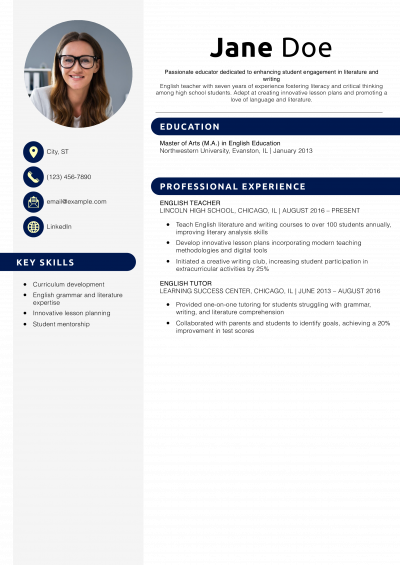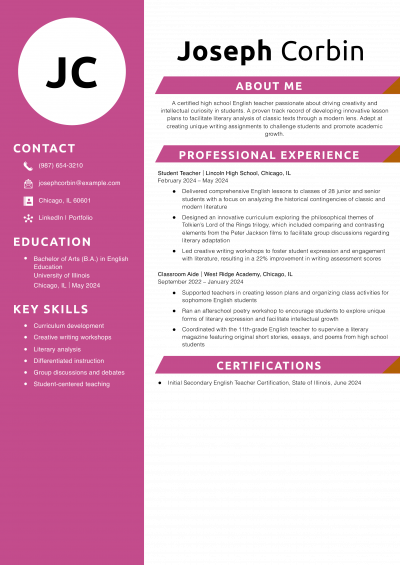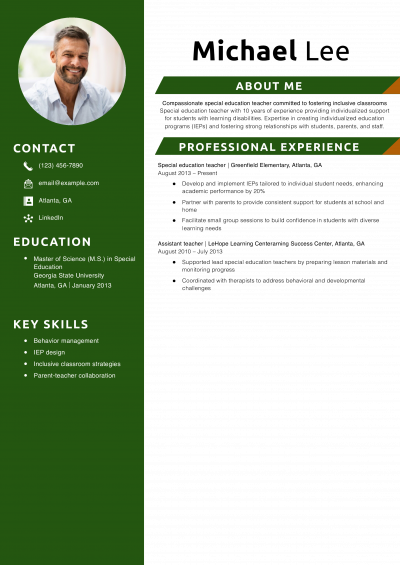As an education professional, your resume must demonstrate an ability to create engaging academic experiences within a positive and inclusive learning environment. It should show a dedication to student development and highlight your unique contributions to the field. This guide will provide writing tips to help you create a results-driven education resume.
Key takeaways:
- Highlight educational focus: Define which area of the field you specialize in, whether that’s teaching, curriculum development, or educational leadership. Engage hiring managers from the start by leading with your expertise in the profile section.
- Quantify your impact: Hiring managers want concrete examples of your past success in education. Use numbers to measure results you’ve achieved in things like performance improvements, increased enrollment, and student retention rates.
- Use job-specific keywords: If an organization uses an Applicant Tracking System (ATS), it relies on this technology to filter out candidates who don’t align with the education job. Take a proactive approach and include keywords found in the job description.
Most Popular Education Resumes
Early Childhood Education Specialist Resume Example
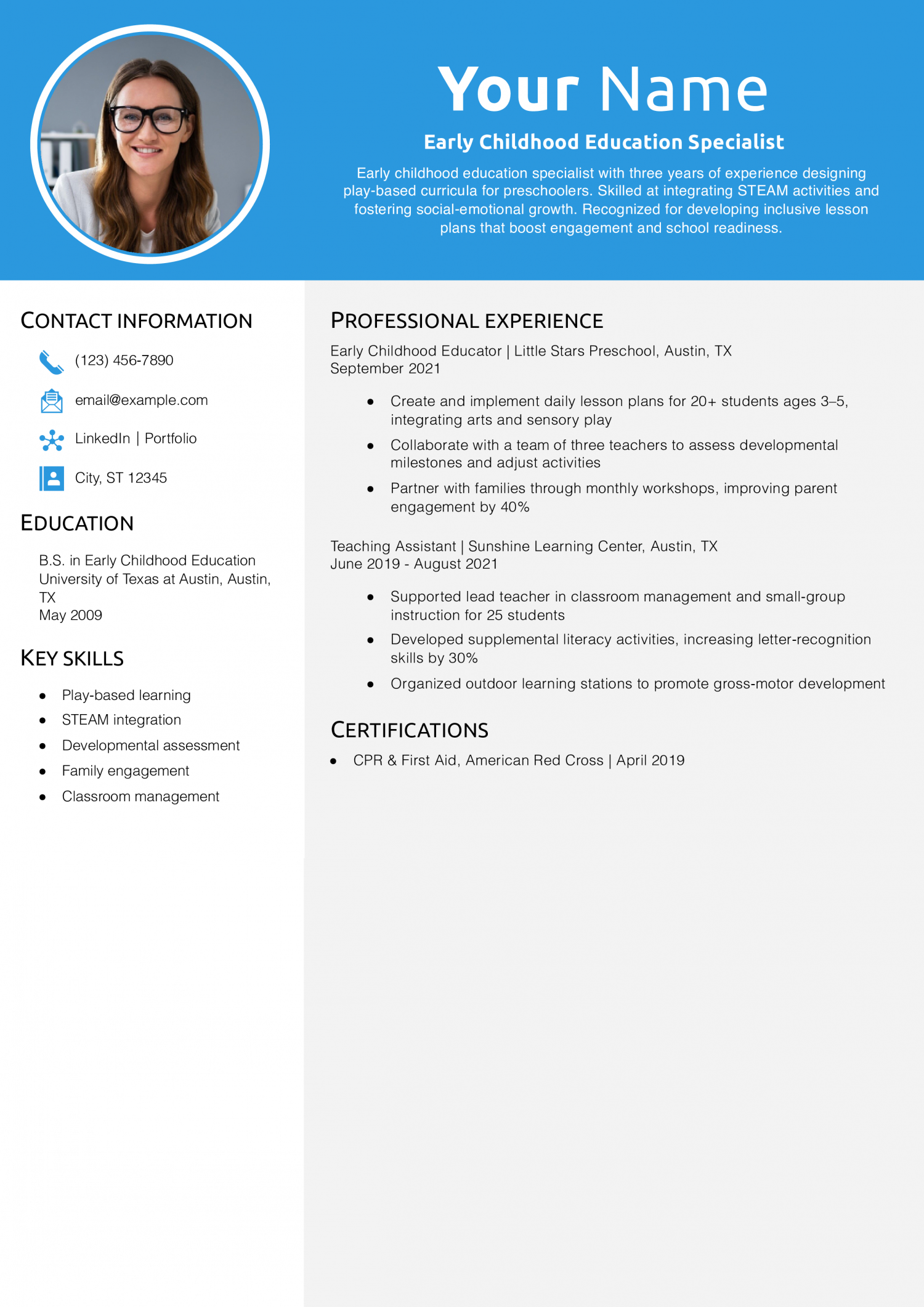
Why This Resume Is a Great Example
This resume highlights both curriculum design and family partnership metrics, demonstrating impact on student outcomes and engagement. The clear profile and bullet points allow recruiters to quickly see core expertise.
Key Tips
Emphasize your classroom outcomes and parent‑engagement initiatives to showcase holistic impact. For guidance on making a resume, see How to Make a Resume.
Music Education Specialist Resume Example
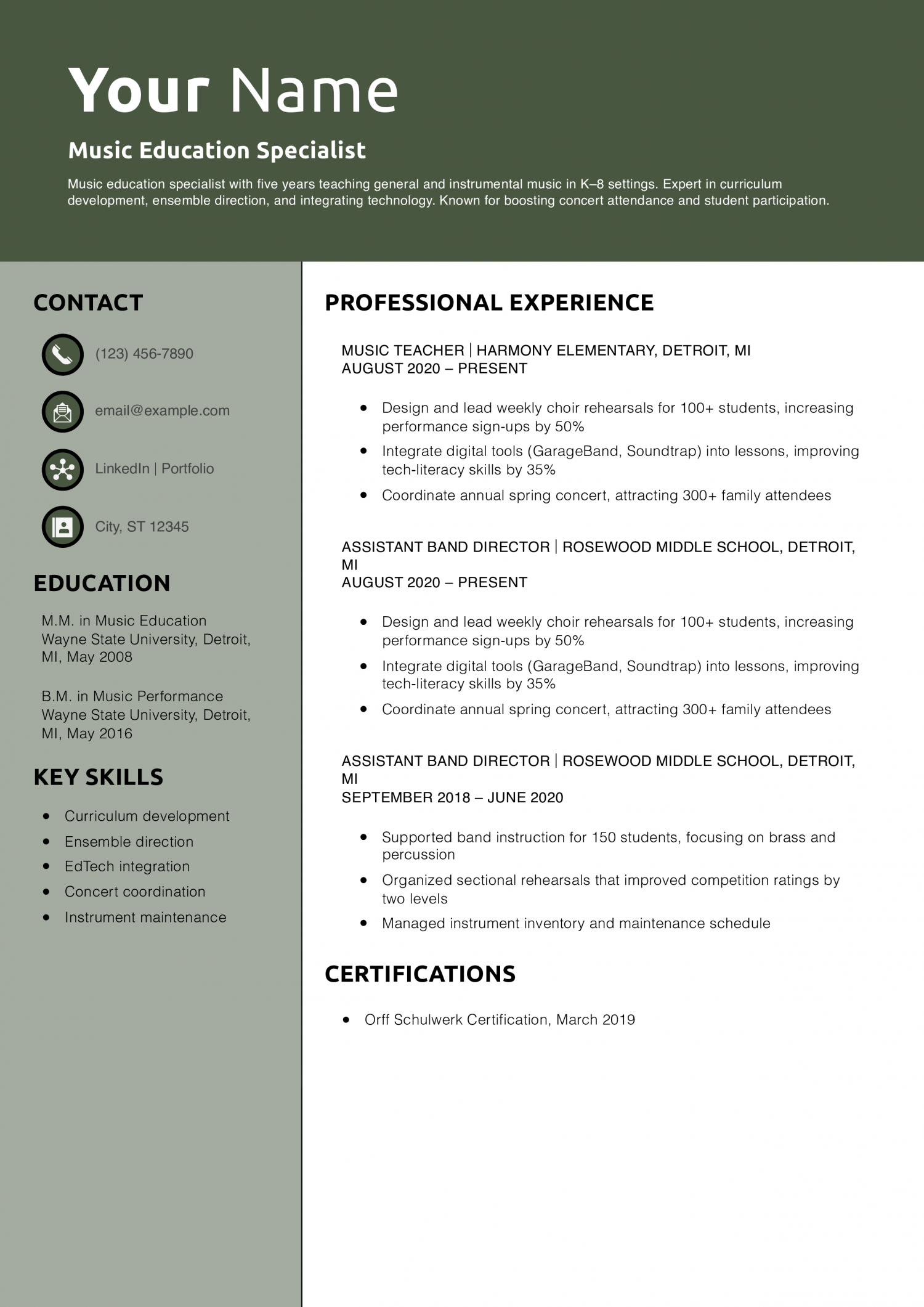
Why This Resume Is a Great Example
This resume quantifies both student participation and technology integration, showing leadership in traditional and digital music education. The dual degrees reinforce specialized expertise.
Key Tips
Highlight your concert and tech‑integration metrics to illustrate engagement. For advice on selecting skills, see Skills to Put on Resume.
Physical Education Teacher Resume Example

Why This Resume Is a Great Example
This resume ties curriculum design to clear fitness and participation metrics, demonstrating both program impact and event leadership. The profile underscores years of experience.
Key Tips
To demonstrate effectiveness, link your lesson outcomes to measurable fitness improvements. For tips on format, see Best Resume Formats.
Education Assistant Resume Example
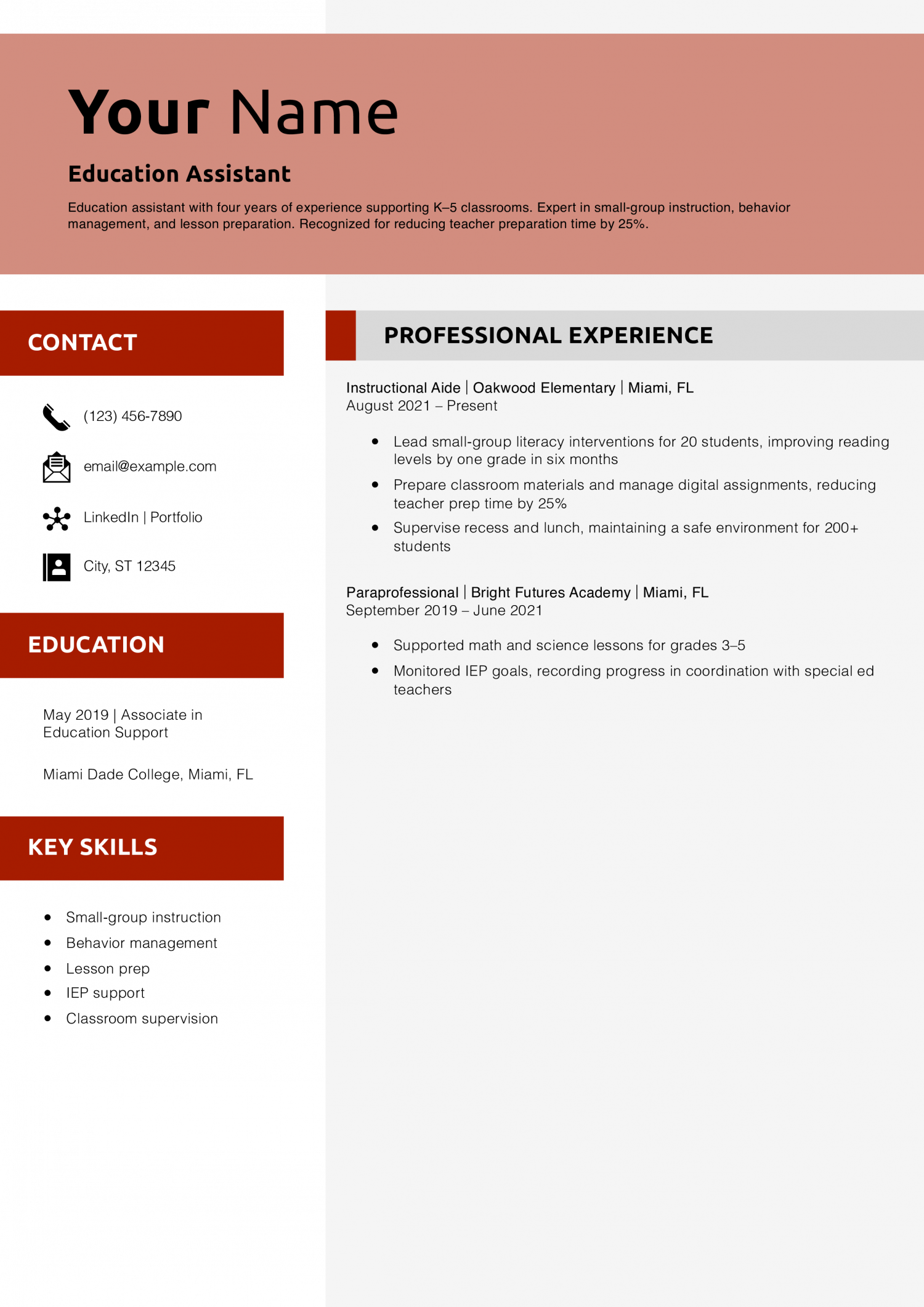
Why This Resume Is a Great Example
This resume quantifies both instructional outcomes and prep‑time savings, highlighting tangible support contributions. The clear bullets allow quick comprehension of responsibilities.
Key Tips
Emphasize your impact on teacher efficiency and student progress to showcase value. For sample objectives, see Resume Objective Examples.
Elementary School Teacher
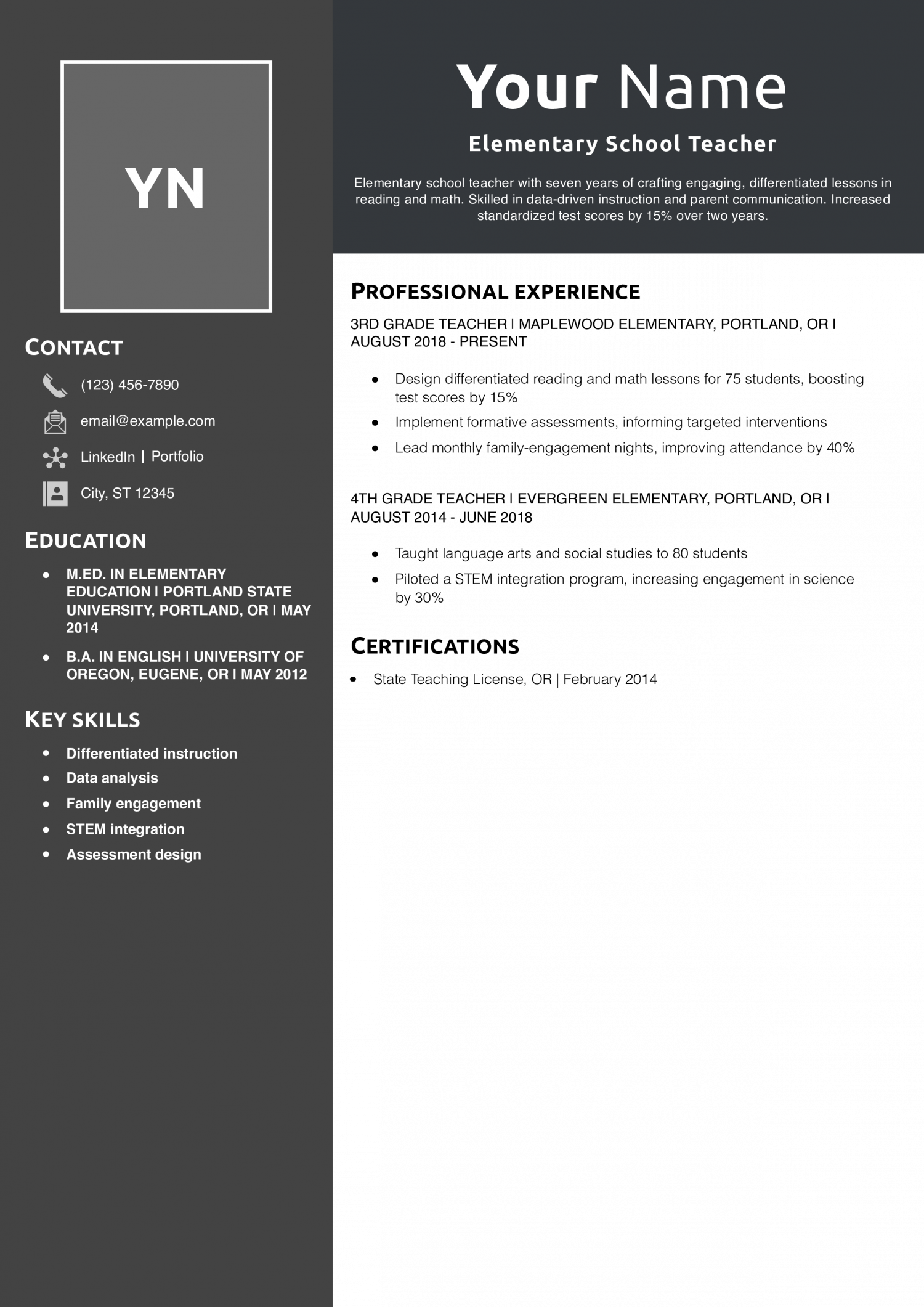
Why This Resume Is a Great Example
This resume connects instructional strategies to test‑score improvements and family engagement metrics, showcasing both academic and community impact. The dual degrees add depth.
Key Tips
Link your instructional initiatives to assessment gains to demonstrate effectiveness. For crafting summaries, see How to Write a Resume Summary.
Higher Education Program Coordinator Resume Example
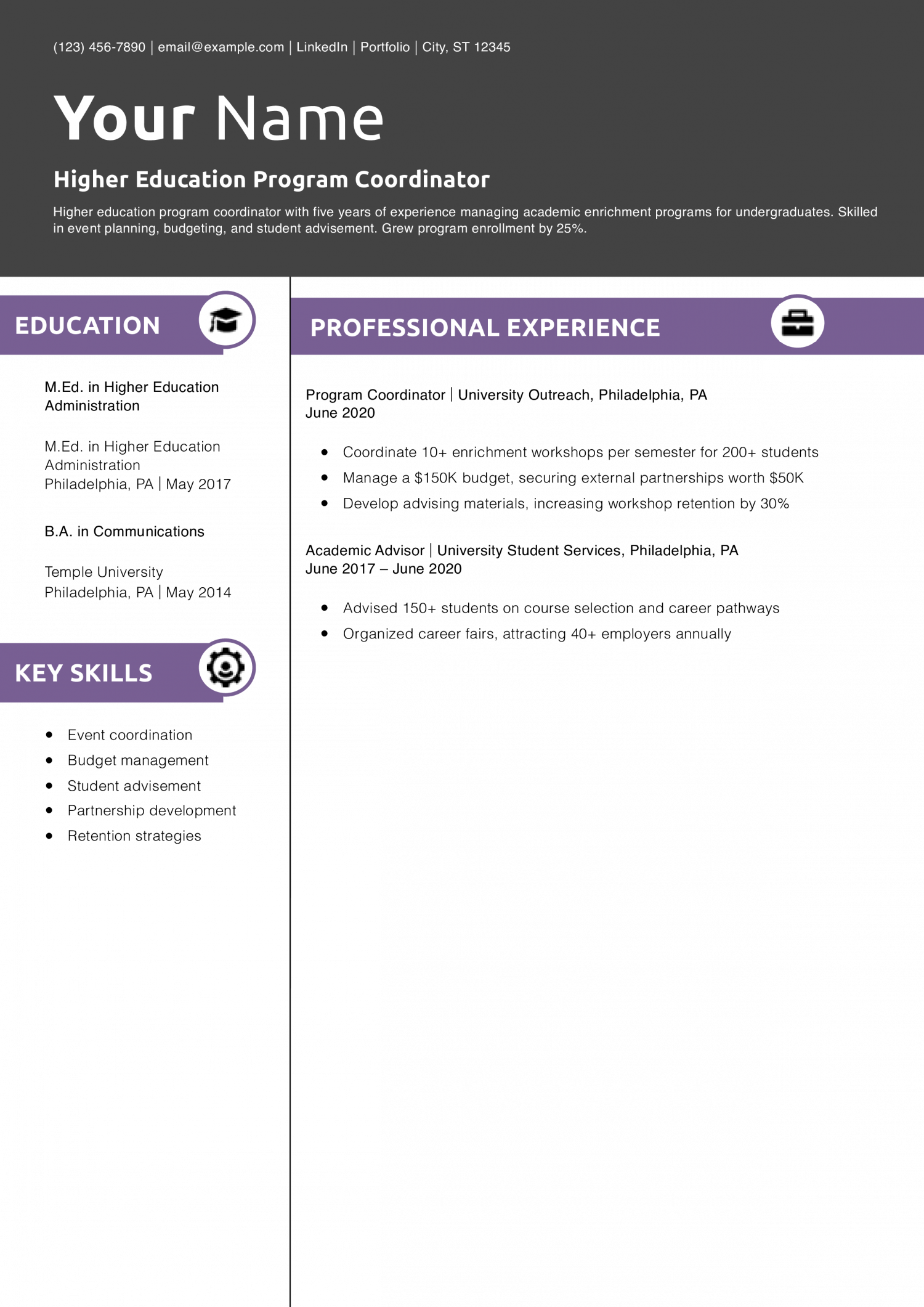
Why This Resume Is a Great Example
This resume highlights both program growth and budget‑management successes, demonstrating strategic coordination skills. The clear profile frames responsibilities effectively.
Key Tips
Emphasize partnership and retention metrics to illustrate program impact. For ideas on hobbies, see What Hobbies to Put on a Resume.
Art Education Instructor Resume Example
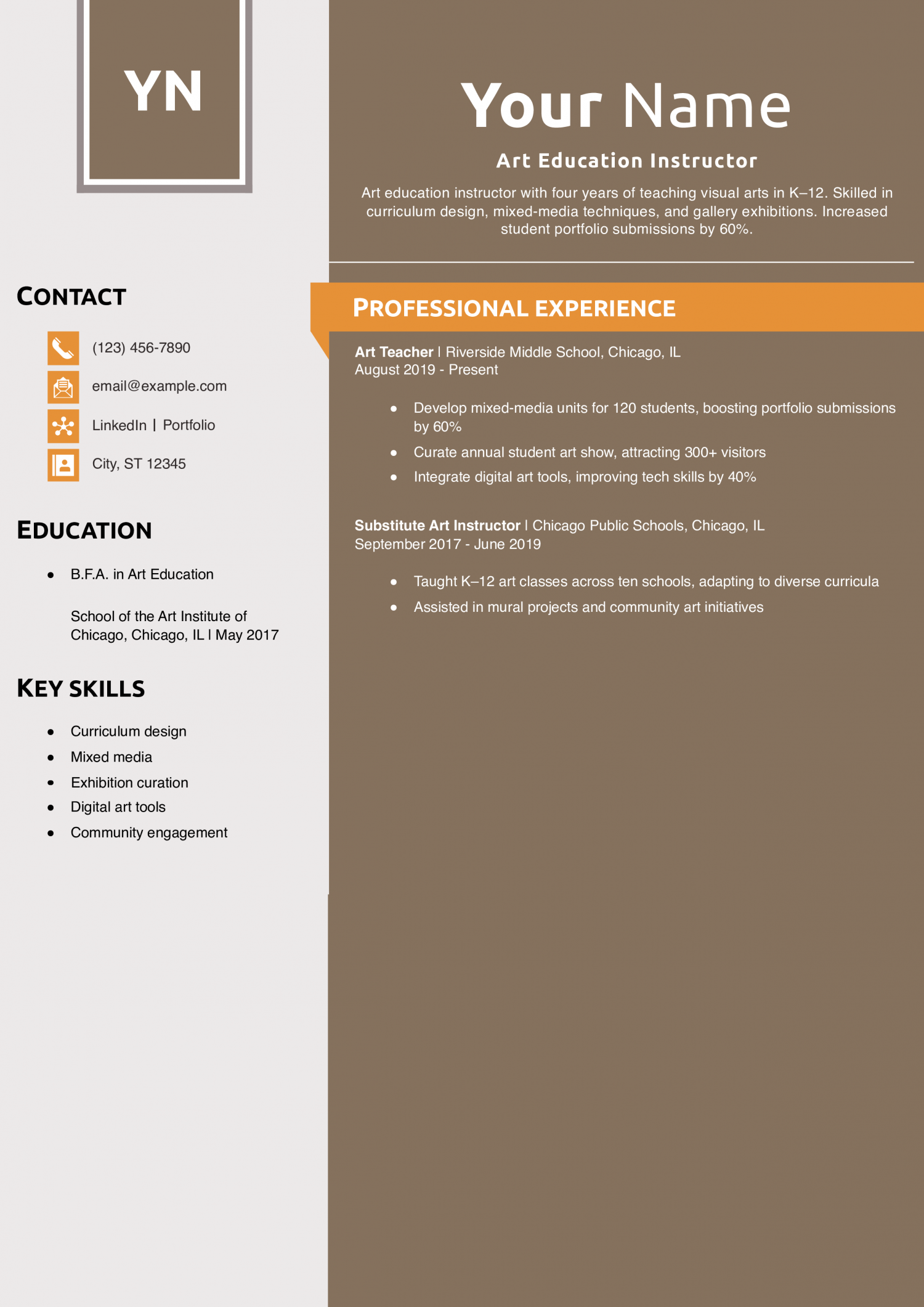
Why This Resume Is a Great Example
This resume quantifies both portfolio and exhibition success, showcasing curriculum impact and community engagement. The profile and bullets clearly convey artistic leadership.
Key Tips
Link your creative initiatives to student outcomes to demonstrate influence. For guidance on listing education, see How to List Education on a Resume.
Childcare Educator Resume Example
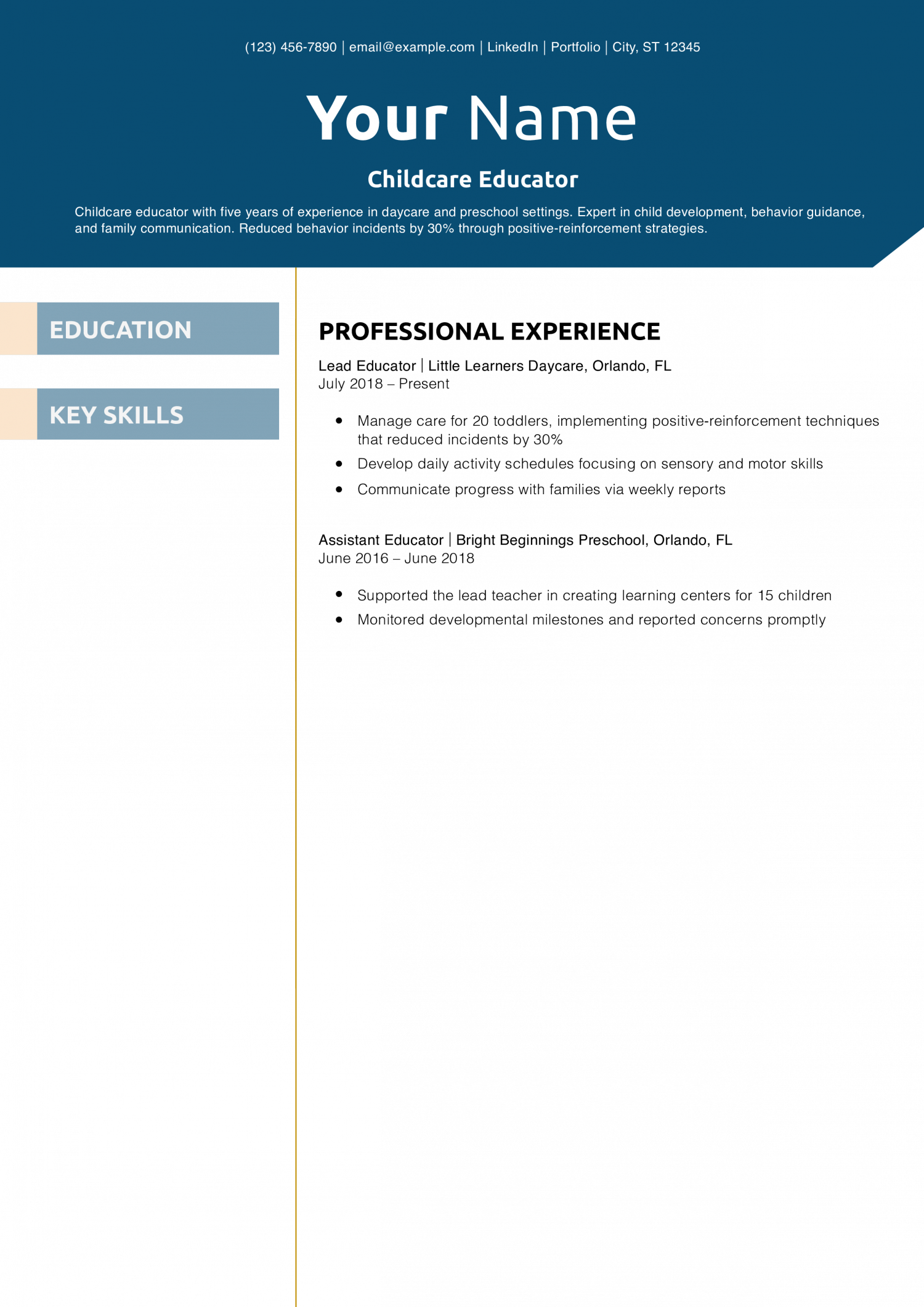
Why This Resume Is a Great Example
This resume links behavior‑management strategies to incident reduction, demonstrating both care and effectiveness. The bullet points highlight essential childcare competencies.
Key Tips
Emphasize your behavior‑guidance outcomes and family‑communication practices. For advice on resume length, see How Far Should a Resume Go.
Continuing Education Coordinator Resume Example
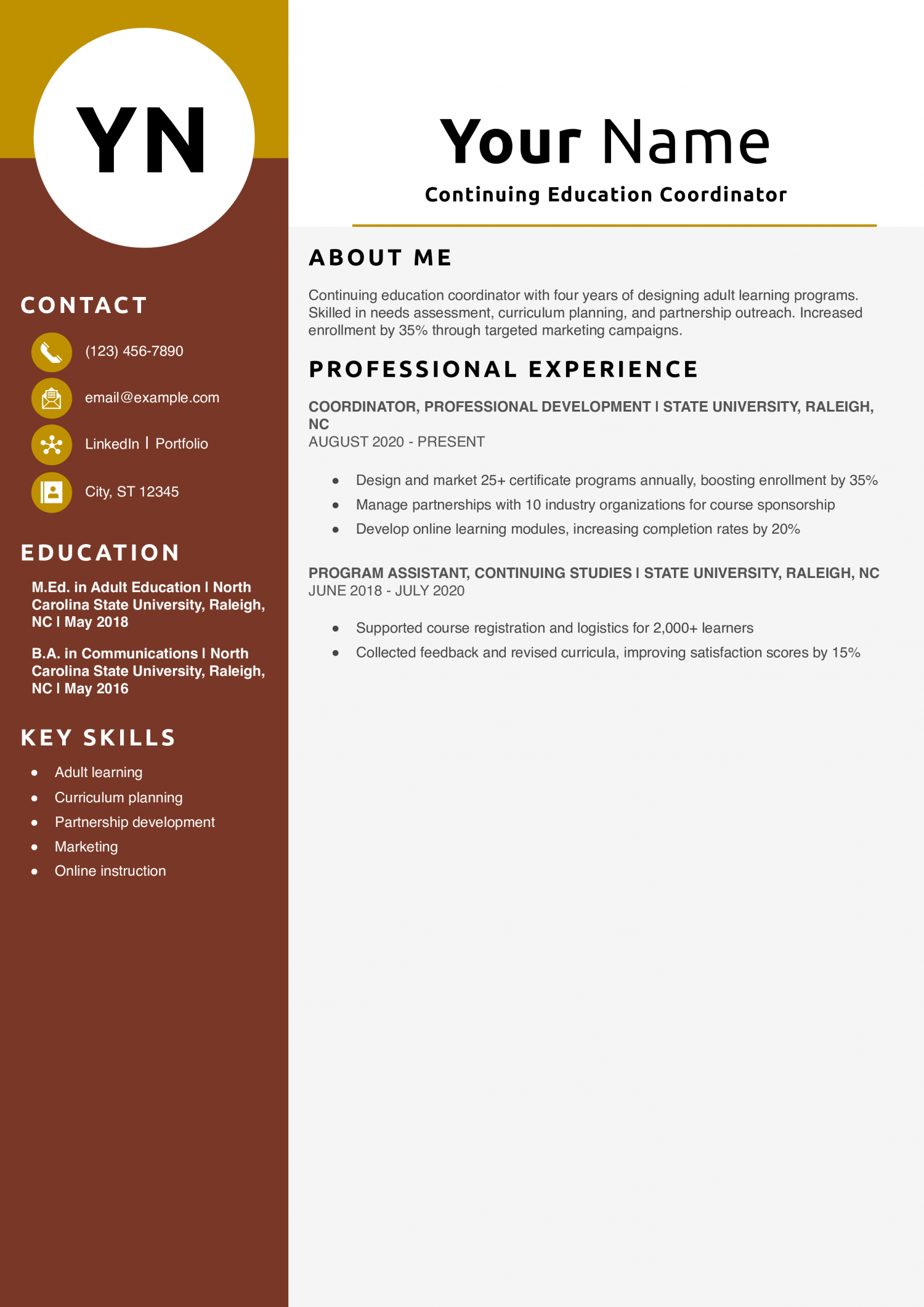
Why This Resume Is a Great Example
This resume ties program design and marketing to clear enrollment and completion metrics, demonstrating strategic program growth. The dual degrees reinforce instructional expertise.
Key Tips
Highlight your enrollment and completion gains to show program success. For ideas on resume content, see What to Put on a Resume.
Nurse Educator Resume Example
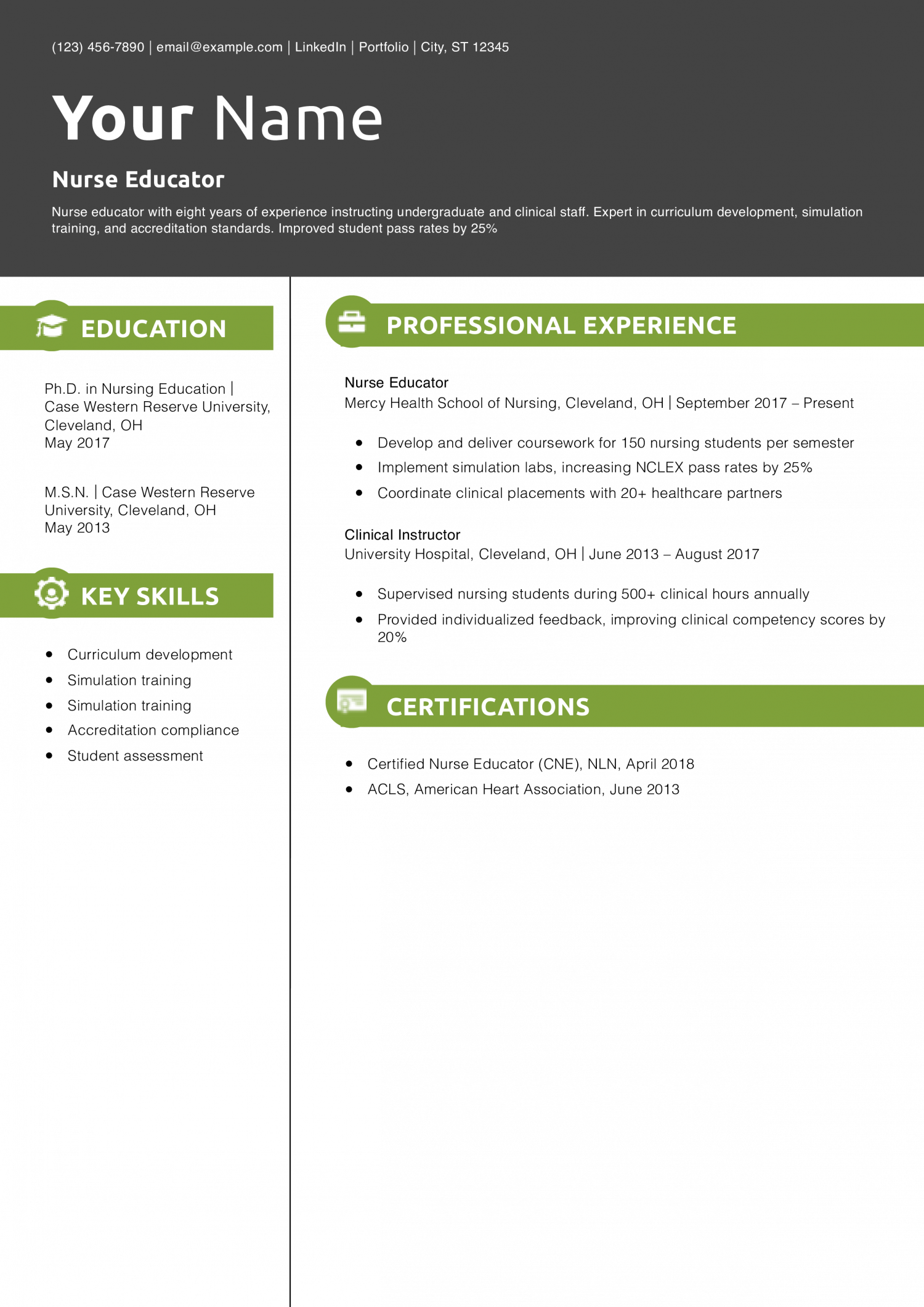
Why This Resume Is a Great Example
This resume connects educational innovation to NCLEX pass‑rate improvements, showcasing both curriculum and clinical expertise. The advanced degrees underline subject‑matter authority.
Key Tips
Tie your educational outcomes to accreditation and exam‑pass metrics to demonstrate effectiveness. For insights on resume objectives, see Resume Objective Examples.
STEM Education Coordinator Resume Example
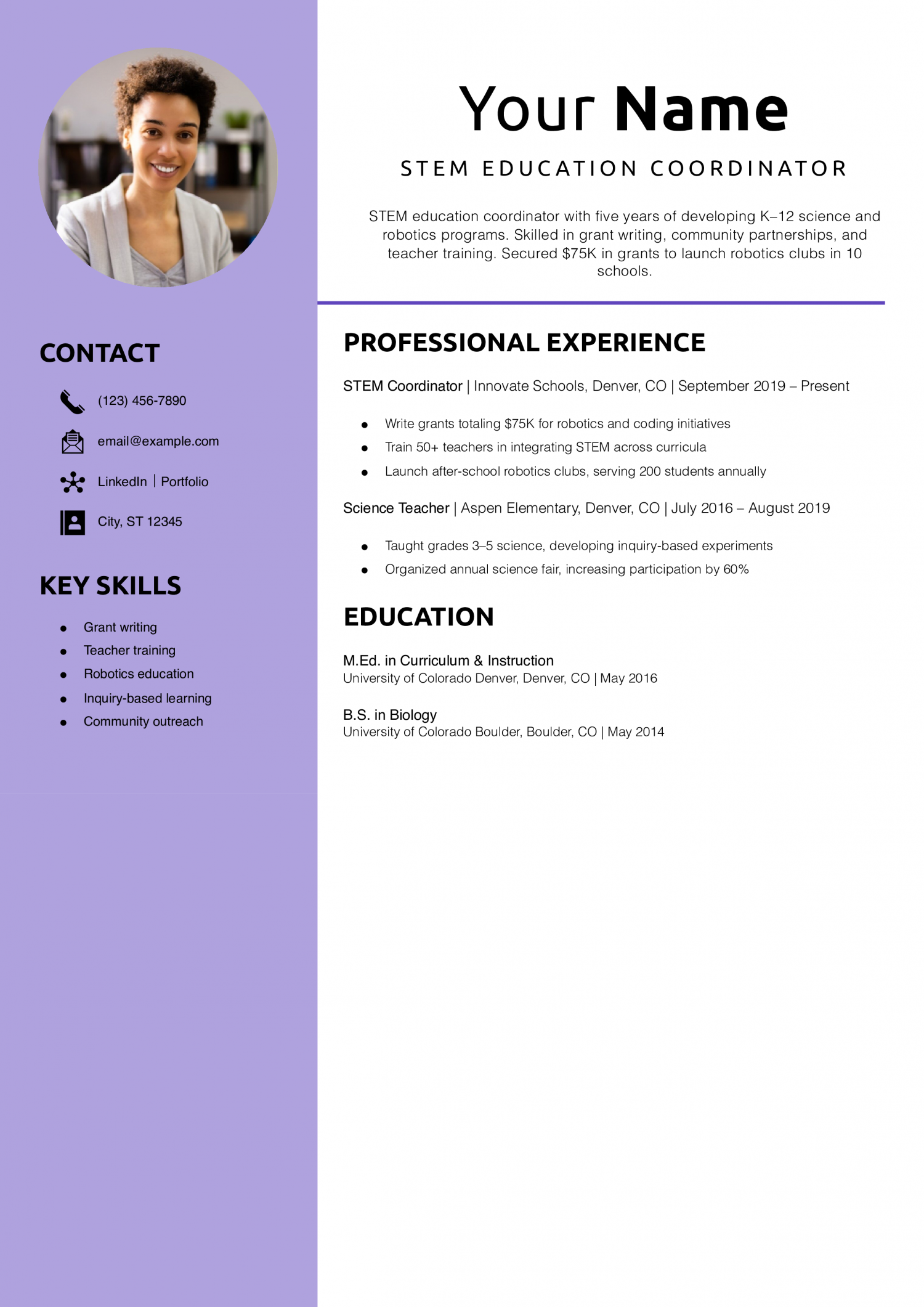
Why This Resume Is a Great Example
This resume highlights both funding success and program growth, demonstrating strategic coordination and instructional leadership. The clear metrics convey impact.
Key Tips
Showcase your grant achievements and training outcomes to illustrate program development. For formatting student resumes, see How a Resume Should Look for a College Student.
Special Education Teacher Resume Example
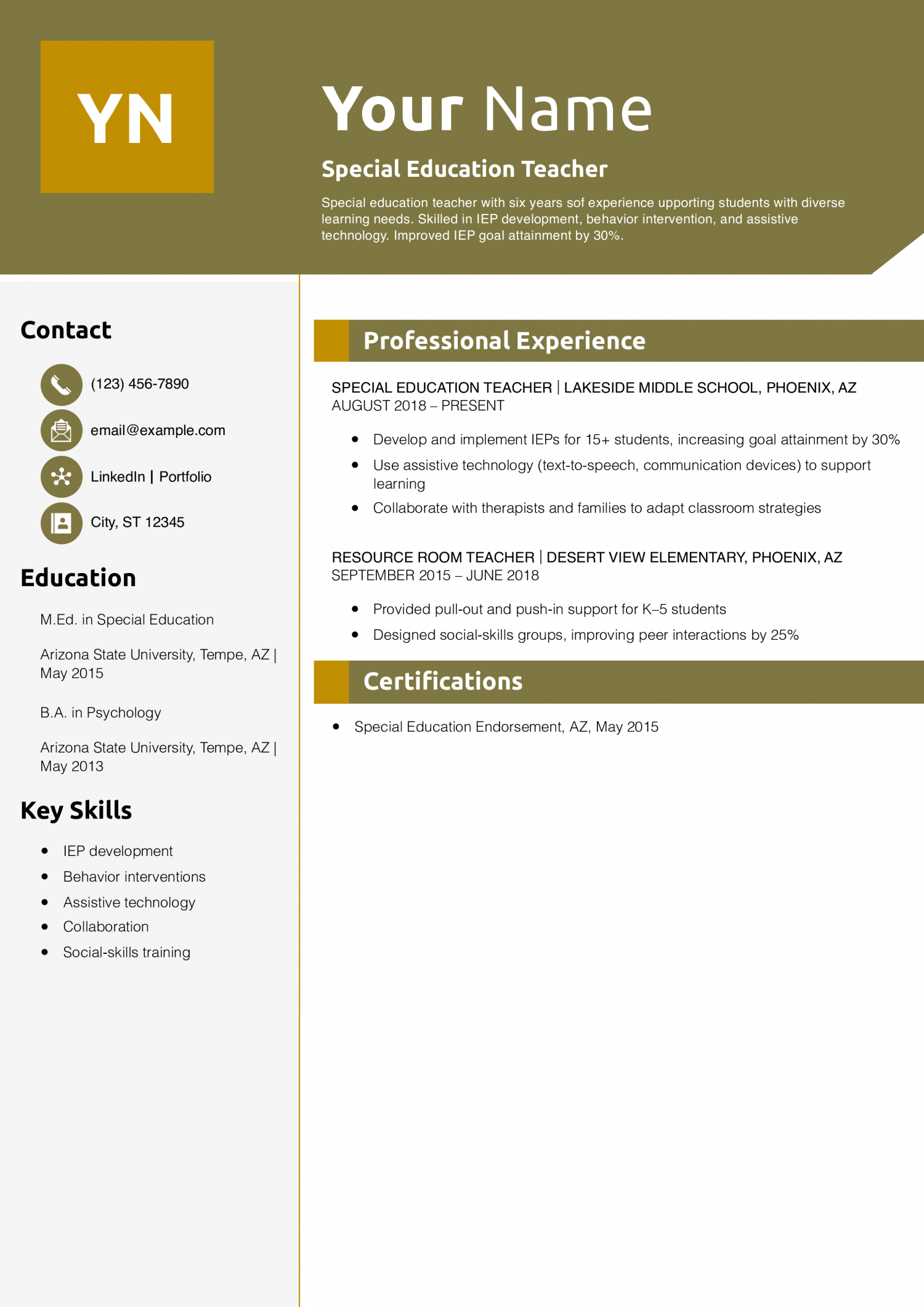
Why This Resume Is a Great Example
This resume connects specialized instruction to IEP success and social‑skills gains, demonstrating both technical and interpersonal expertise. The bullet points clearly show outcomes.
Key Tips
Tie your interventions to measurable student progress to highlight effectiveness. For leadership‑skill examples, see Leadership Skills for Resume With Examples.
Montessori Educator Resume Example
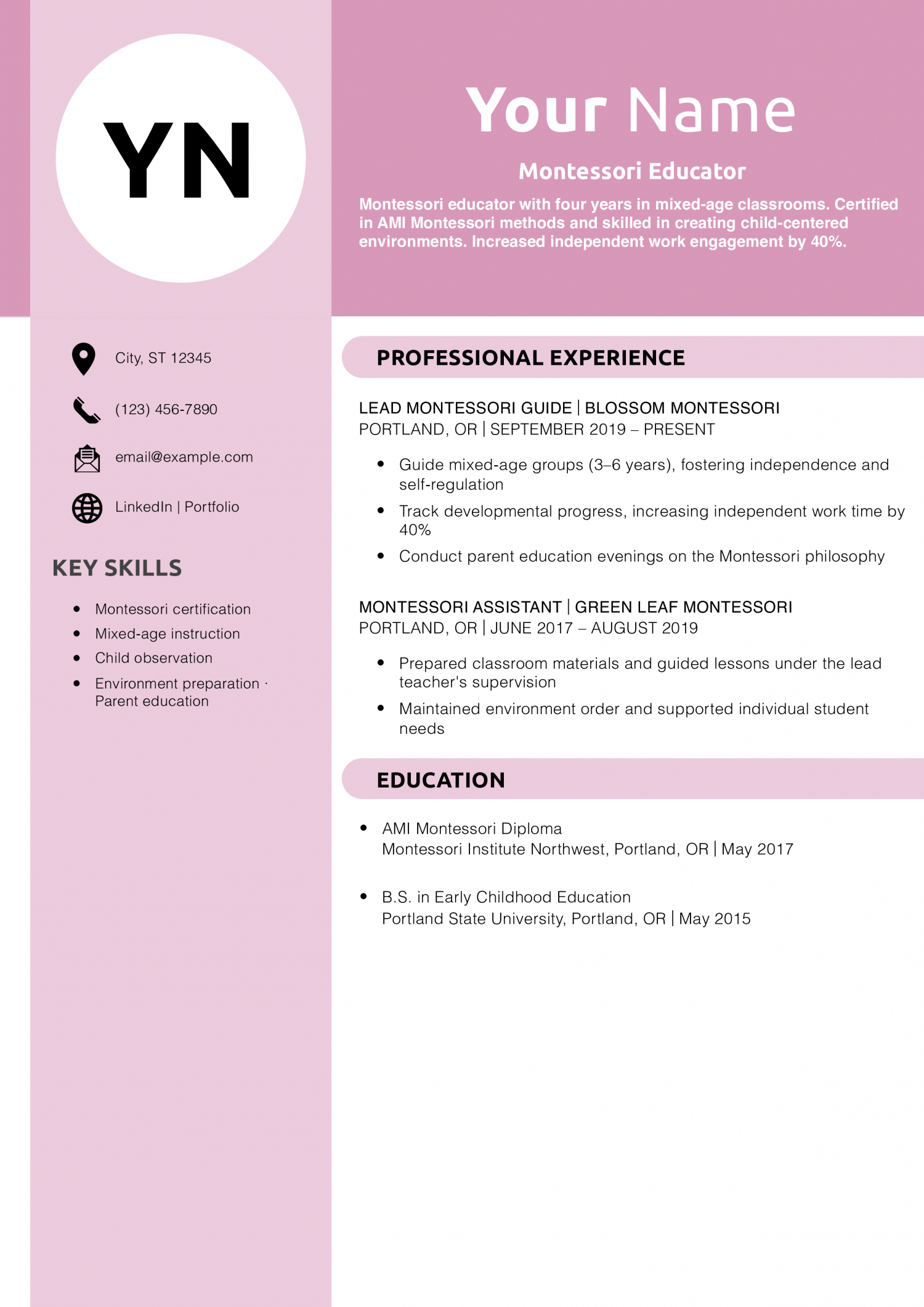
Why This Resume Is a Great Example
This resume highlights both certification and measurable engagement gains, demonstrating authentic Montessori practice. The profile sets clear expectations for methodology.
Key Tips
Emphasize your certification and engagement metrics to showcase expertise. For resume update tips, see How to Update Your Resume.
ESL Teacher Resume Example
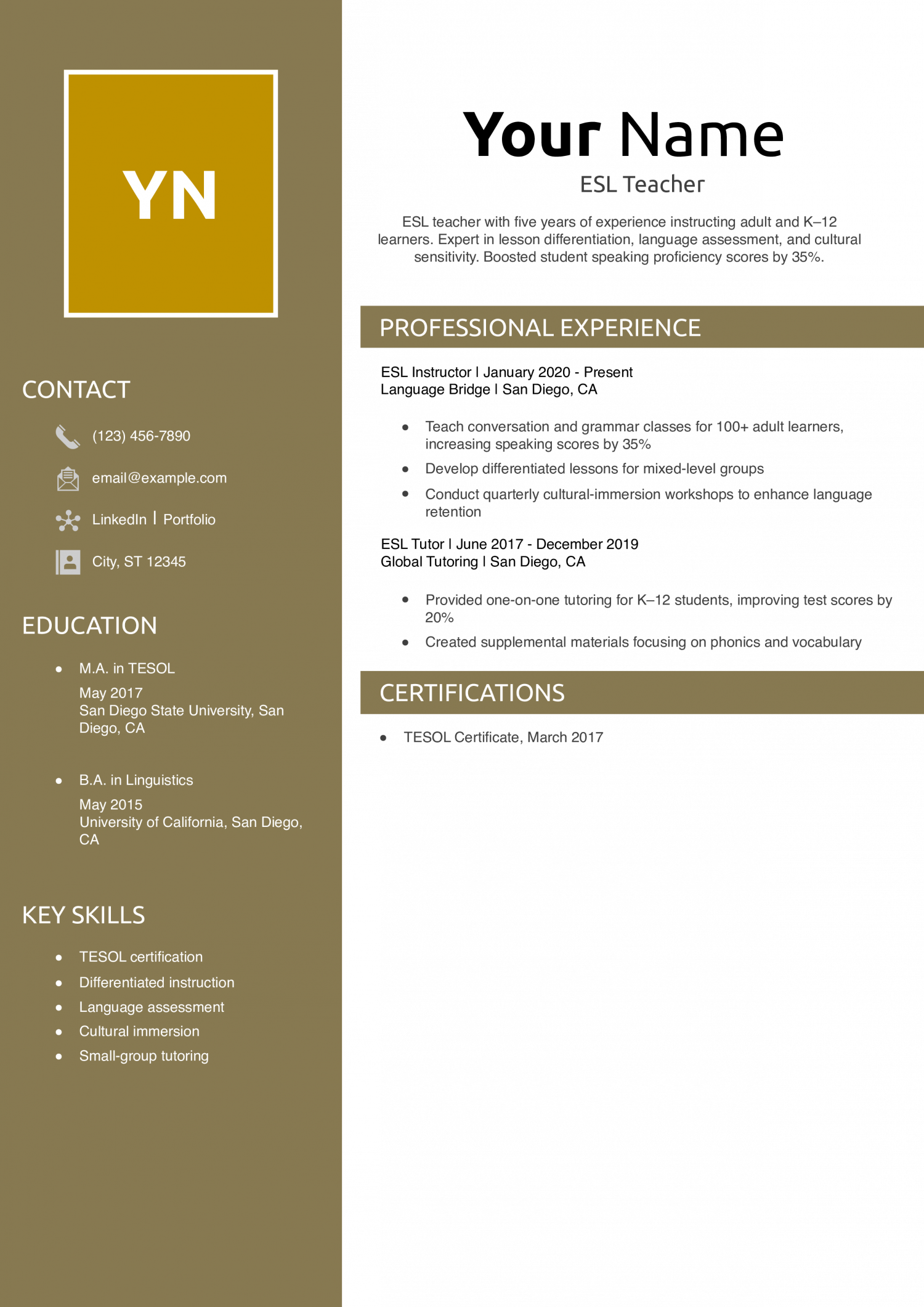
Why This Resume Is a Great Example
This resume connects instructional strategies to proficiency gains, demonstrating both adult and K–12 expertise. The profile and bullets clearly showcase outcomes.
Key Tips
Highlight your assessment results and cultural‑immersion initiatives to show depth. For job‑title ideas, see Job Title Examples for Your Resume.
Career & Technical Education Instructor Resume Example
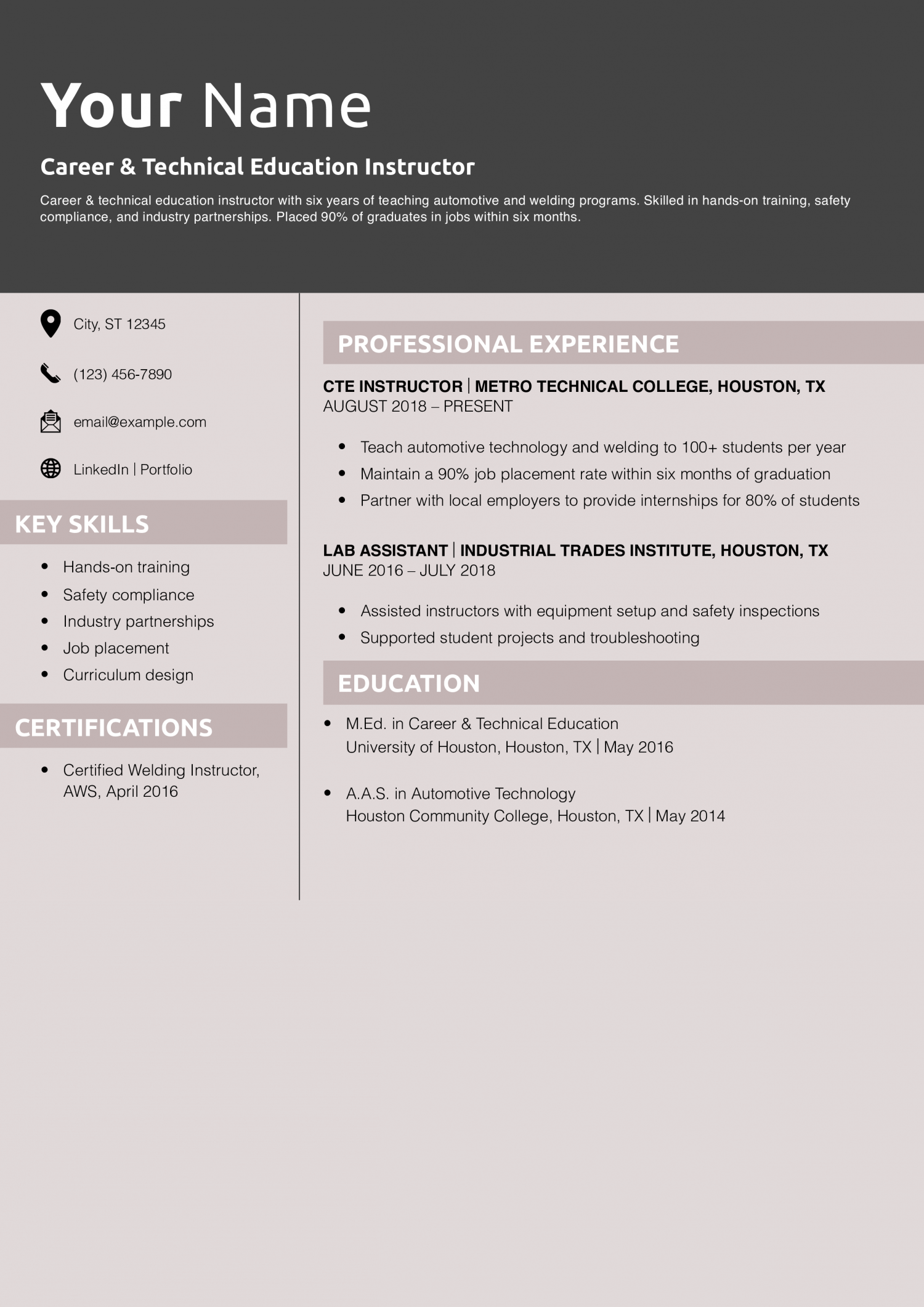
Why This Resume Is a Great Example
This resume ties program outcomes to job‑placement metrics and industry partnerships, demonstrating real‑world impact. The dual roles show growth from assistant to lead instructor.
Key Tips
Emphasize placement rates and partnerships to illustrate industry relevance. For tips on building a resume, see How to Write a Convincing Resume Profile.
Education Technology Specialist Resume Example

Why This Resume Is a Great Example
This resume quantifies both adoption and engagement metrics, demonstrating the specialist’s ability to drive tech integration. The clear profile outlines core competencies.
Key Tips
Highlight adoption rates and training satisfaction to showcase effectiveness. For resume‑building advice with no experience, see How to Write a Resume With No Experience.
Literacy Coach Resume Example

Why This Resume Is a Great Example
This resume ties professional development and coaching efforts to measurable proficiency gains, highlighting both leadership and instructional prowess. The profile sets clear outcomes.
Key Tips
Emphasize your data analysis and PD impact to demonstrate coaching effectiveness. For personal‑statement ideas, see Resume Personal Statement Examples.
Curriculum Developer Resume Example
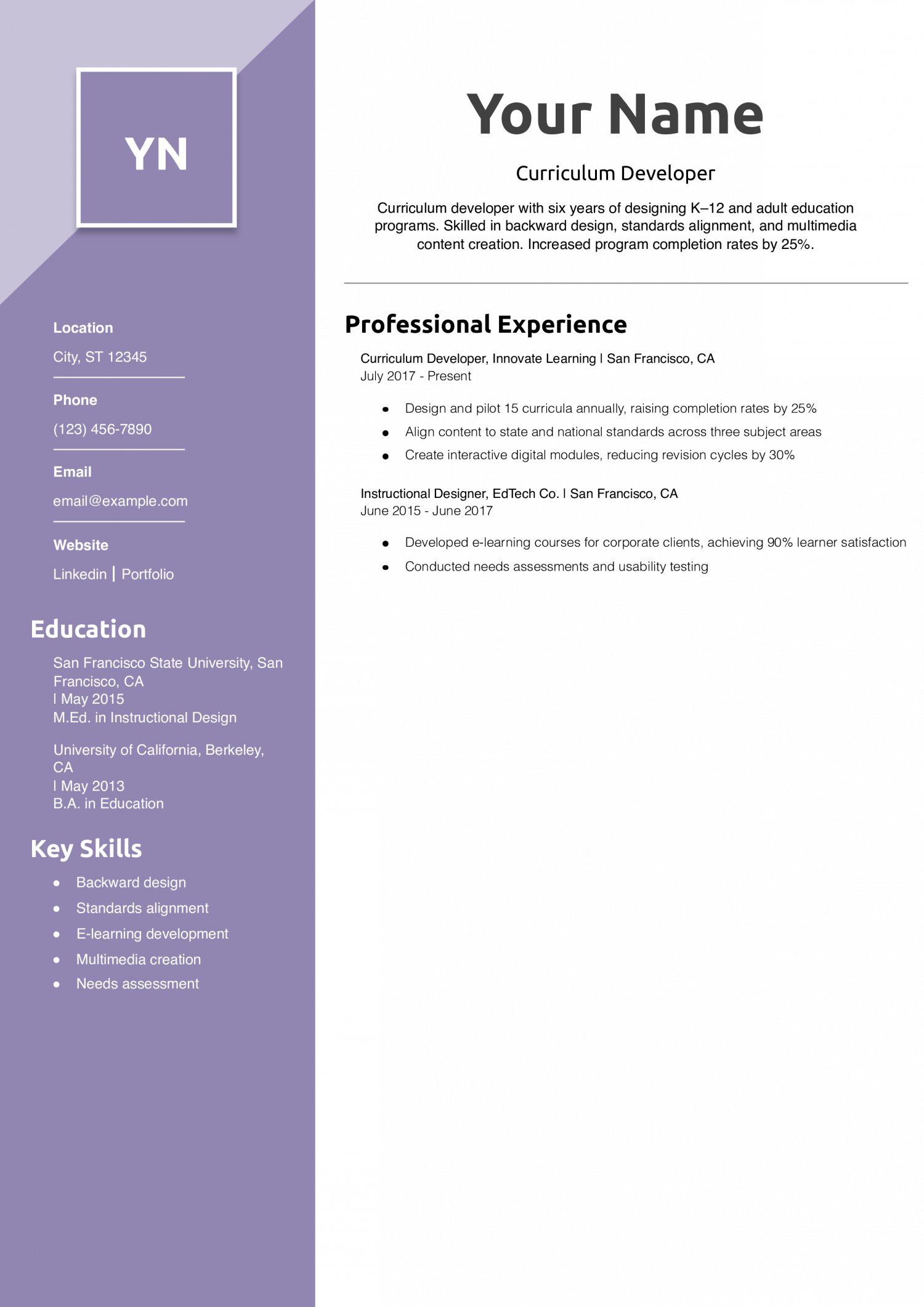
Why This Resume Is a Great Example
This resume quantifies curriculum success and reduction in revision time, showing both design expertise and efficiency. The clear profile highlights instructional design focus.
Key Tips
Highlight completion and revision‑time metrics to underscore curriculum impact. For design insights, see How to Use Bullets Effectively on a Resume.
School Counselor Resume Example
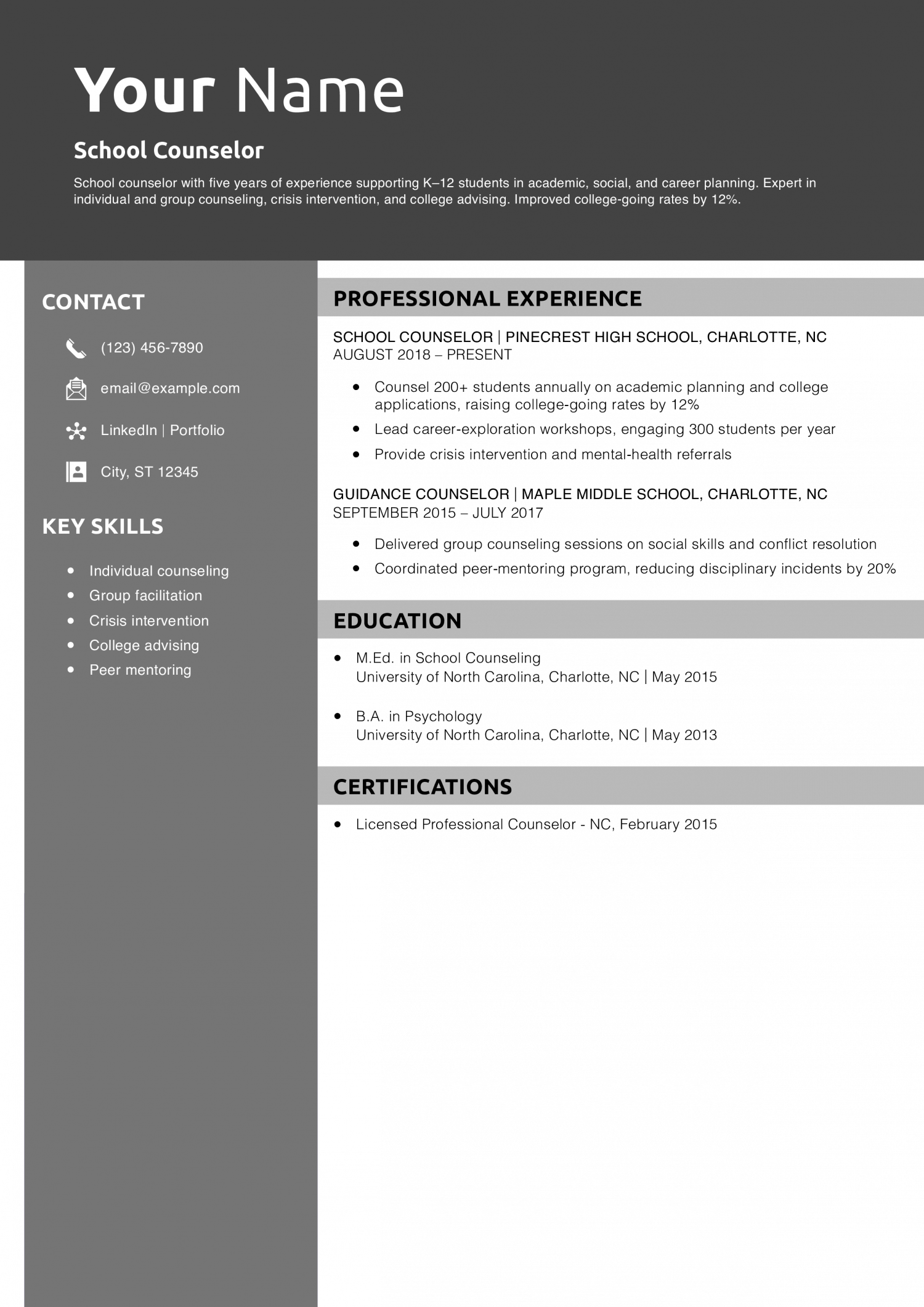
Why This Resume Is a Great Example
This resume ties counseling services to clear college‑going and behavioral outcomes, demonstrating holistic student support. The profile and bullets convey both scope and impact.
Key Tips
Link counseling initiatives to student success metrics to highlight contributions. For best‑looking resume tips, see Best‑Looking Resumes.
Online Course Developer Resume Example
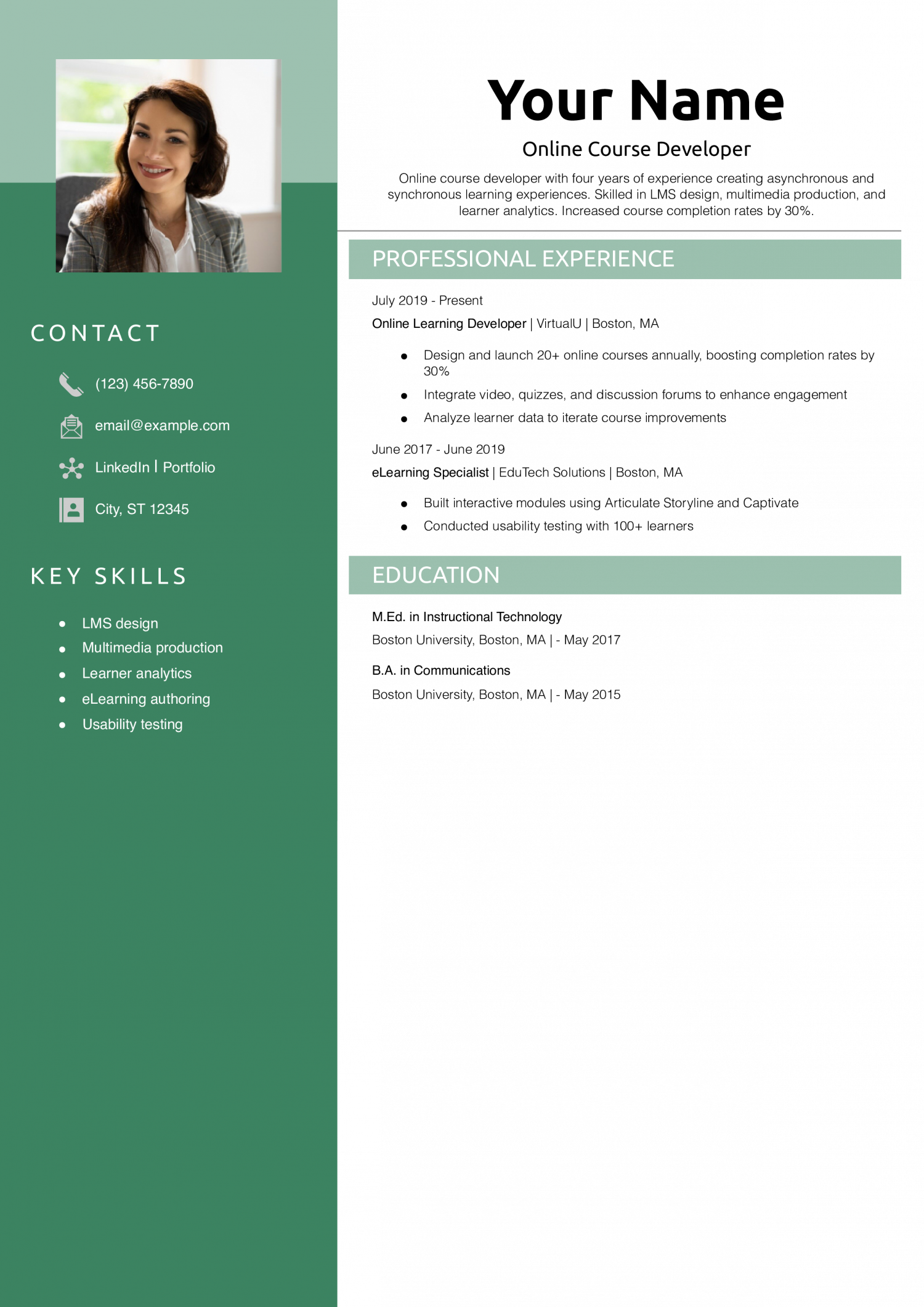
Why This Resume Is a Great Example
This resume quantifies course outcomes and demonstrates both design and analytics expertise. The concise profile frames the developer’s dual focus on engagement and improvement.
Key Tips
Highlight completion-rate improvements and data‑driven refinements to showcase results. For resume planning, see Career Advice: Resume Job Description.
Education Text-Only Resume Examples and Templates
How To Write an Education Resume Example
Whether you’re a teacher, administrator, or consultant, the goal of your resume is to communicate proficiency within your educational occupation. It should set you apart and outline the most compelling aspects of your career. Your education resume should include these sections:
- Contact information
- Profile
- Key skills
- Professional experience
- Education and certifications
1. Share your contact information
Make sure potential employers have all of your most up-to-date contact information. Provide your full name, phone number, email address, location, and a link to your online professional profile. Place all of this within a header at the top of your resume so hiring managers can easily contact you for an interview.
Example
Your Name
(123) 456-7890 | [email protected] | City, State Abbreviation Zip Code | LinkedIn
2. Summarize your education qualifications in a dynamic profile
The profile of your education resume should give potential employers a snapshot of your career highlights. List your years of experience, the types of educational environments you’ve worked in (e.g., public, private, charter), and grades or subjects taught if you’re a teacher. Highlight unique accomplishments and emphasize skills that align with the district’s values and needs.
For instance, if you’re a high school teacher who’s known for after-school science, technology, engineering, and mathematics (STEM) programs, include that information here. Or, if you’ve increased exam pass rates and consistently improved student engagement in challenging subjects, list those numbers in your profile. As you write your profile, keep potential employers in mind and ask yourself, “Which strengths would benefit their organization?”
Senior-Level Profile Example
Student affairs leader with over a decade in higher education administration, known for implementing data-driven strategies to enhance student well-being, retention, and career readiness. Spearheads crisis management solutions that prioritize student success.
Entry-Level Profile Example
Early education specialist known for developing engaging, hands-on learning experiences. Passionate about community partnership to enhance resources and student opportunities. Champions an inclusive learning environment that inspires curiosity and critical thinking.
3. Showcase your education experience
The professional experience section of your education resume is like a personal teaching portfolio. This section is where you list essential duties and measurable results. When describing responsibilities, answer questions like, “How many? How much? How often?” The answers will convey the scope of your work and provide more than a simple list of obligations; however, the focus should be on your career achievements.
Schools and organizations are most interested in seeing how you made an impact within your past positions. For administrators, emphasize policy improvements and successful collaborations with staff and stakeholders. If you’re an educator, highlight success with teaching methods and notable student achievements. These experiences build credibility and show your value.
Senior-Level Professional Experience Example
Dean of Students, University of the Arts, Philadelphia, PA
July 2019 – present
- Oversee a team of 15 student affairs professionals and manage a $2.5 million budget to support more than 1,500 fine art students
- Secured over $300,000 in grants to establish an on-campus makerspace for interdisciplinary collaboration among 11 different art majors
- Increased student retention by 7% through a “Studio to Career” program that pairs juniors with industry professionals and seniors with internship opportunities
- Chaired the institution’s COVID-19 response team and successfully transitioned 100% of student services to virtual platforms within two weeks
Entry-Level Professional Experience Example
After School Program Coordinator, King County, Seattle, WA
September 2023 – present
- Oversee a daily two-hour Science, Technology, Engineering, Arts, and Mathematics (STEAM) after-school program alongside a team of five staff members
- Serve over 50 students in second through fifth grade and coordinate 15 hands-on STEAM activities per week, including robotics, coding, painting, and experiments
- Establish partnerships with local tech companies, securing over $10,000 in sponsorships and 12 refurbished laptops for the program
- Increased female participation from 30% to 50% over one academic year by initiating a ‘Girls-STEAM-Ahead’ mentorship program
Resume writer’s tip: Quantify your experience
Quantifying your experience makes your contributions clear, concrete, and compelling. Use percentages, dollar amounts, and performance metrics to make your accomplishments more tangible and memorable. Show how your curriculum design led to improved test scores or your grant writing skills secured additional funding.
Do
- “Improved average digital student engagement time from 18 minutes to 40 minutes with the development of 20 new game-based learning modules”
Don’t
- “Developed new game-based modules that performed well”
Resume writer’s tip: Tailor your resume for each application
Every position will be unique to that school and district, having its own culture, priorities, and student demographics. Your education resume should reflect that you understand and are prepared to meet these specific needs.
Start by studying the school’s job description and adjust your resume accordingly. Match your education skills and qualifications with those required for the job and incorporate them into your professional experience section, profile, and skills list. This strategy will help you stand out from other qualified education professionals and show you did your homework.
What if you don’t have experience?
If you’re searching for your first teaching job or making the switch from a corporate office to a school district office, remember everyone starts where you are.
For educators, focus on your own education. Go into greater detail here than you normally would. List coursework, honors, majors, and projects. Feature the practical portion of your teaching program in the professional experience section. If you volunteered or student-taught in any kind of school setting, describe what you did and the skills you used.
If you’re on the administrative or operational side of education, lean into your technical and interpersonal skills. Work experience from other industries can transfer, but present it in a way that hiring managers within education can understand. Frame your past achievements and skills list to connect with the demands of an education position.
4. Outline your academic history and education-related certifications
Always start with your most advanced degree first, typically a bachelor’s or master’s degree in education or your specific subject area. Include the degree name, school, and graduation year. If you specialize in things like special education, English as a Second Language (ESL), or STEM, be sure to mention that here and highlight any relevant coursework.
In the certification section, you’ll need to list your teaching license or certificate, depending on your state’s requirements. Also include credentials that could help you stand out from other educators (e.g., first aid/CPR, Advanced Placement, National Board Certification).
Education
Template:
[Degree Name]
[School Name], [City, State Abbreviation] | [Graduation Year]
Example:
Master of Science (M.S.) Curriculum Instruction
University of Michigan, Ann Arbor, MI | June 2024
Certifications
Template:
[Certification Name], [Awarding Organization], [Completion Year]
Example:
Michigan State Teaching Certification, Michigan Department of Education, 2016
5. List key education skills and proficiencies
Your key skills should include a combination of the knowledge, techniques, and personal attributes you’ve developed over the years. This simple list helps hiring managers quickly grasp what you could contribute to their school, students, or clientele. Include hard and soft skills mentioned in the job description of the education position you’re applying for.
| Hard Skills | |
|---|---|
| Assessment design | Classroom management software (ClassDojo, Google Classroom, Edmodo) |
| Curriculum development | Data analysis (PowerSchool Analytics, Tableau, Power BI) |
| ESL techniques | Lesson planning |
| Online course management (Canvas, Blackboard, Moodle) | Student engagement techniques |
| Subject matter expertise (art, English, math) | Technology integration (Google Workspace for Education, Apple Classroom) |
| Soft Skills | |
|---|---|
| Adaptive teaching | Conflict resolution |
| Cross-curricular integration | Emotional intelligence |
| Interdisciplinary collaboration | Multilingual learner support |
| Parent-teacher communication | Restorative justice and positive reinforcement |
| Social-emotional learning (SEL) integration | Trauma-informed practice |
Resume writer’s tip: Use common action verbs
Clearly articulate the impact you’ve had on your students or education communities by using action verbs. These engaging words help you communicate information clearly and concisely. They get straight to the heart of what you’re trying to describe. Make the most of the limited space you have by using the action verbs below on your education resume:
| Action Verbs | |
|---|---|
| Adapted | Coordinated |
| Designed | Developed |
| Encouraged | Engaged |
| Facilitated | Implemented |
| Instructed | Integrated |
| Mentored | Monitored |
| Motivated | Taught |
How To Pick the Best Education Resume Template
A traditional, professional resume template is often best for education positions. While it’s tempting to choose a template that you like, consider the unique aspects of your field and the expectations of potential employers.
Avoid templates with flashy graphics and loud colors. These may look fun and creative but might distract from your qualifications. You may have more leeway if you’re applying to an arts-focused school; however, for most public and private educational institutions, keep it conservative.
Frequently Asked Questions: Education Resume Examples and Advice
To effectively tailor your Education CV, start by highlighting key skills and experiences that match the job description. Look for keywords from the job posting, such as specific tools, certifications, or industry terms, and integrate them naturally into your CV. This customization will make your CV more relevant and increase your chances of passing ATS scans.
Each year, there are over 850,000 job openings within the educational instruction and library sector, providing plenty of opportunities for professionals within education. However, to land your dream teaching job or secure a role in the best districts, you need to present yourself as the perfect fit for the role.
Sit down with a notebook and create a list of keywords you find in the job description. These phrases will be skills and requirements that match your experiences. Then use this same terminology throughout your resume in a natural way, reordering skills and adjusting bullet points to match your priority list. Remember to give context to these qualifications so they make sense and align with the job.
The most effective layout for an education resume is the chronological format. Experience is key in education, no matter your role. Hiring managers need to know you can handle the demands of teaching, leading, and serving within the field. This is also the format that school administrators and hiring committees are most familiar with, making it easy for them to read and capture your qualifications quickly.
Include a cover letter with your resume
A resume can only say so much about your work experience. If you find yourself wishing you could elaborate more on a teaching experience or share a specific personal anecdote, a cover letter is the answer. To give yourself the best chance of securing an interview, pair your resume with a thoughtful, personalized cover letter that explains why you’re the right person for the job.
Check Out Related Examples
Resume Templates offers HR approved resume templates to help you create a professional resume in minutes. Choose from several template options and even pre-populate a resume from your profile.

